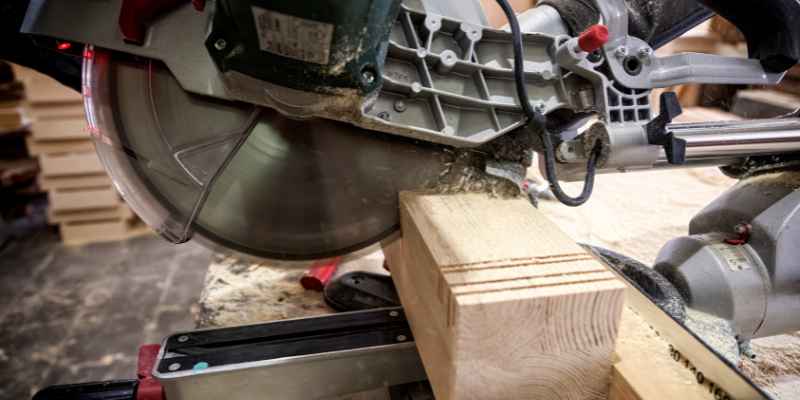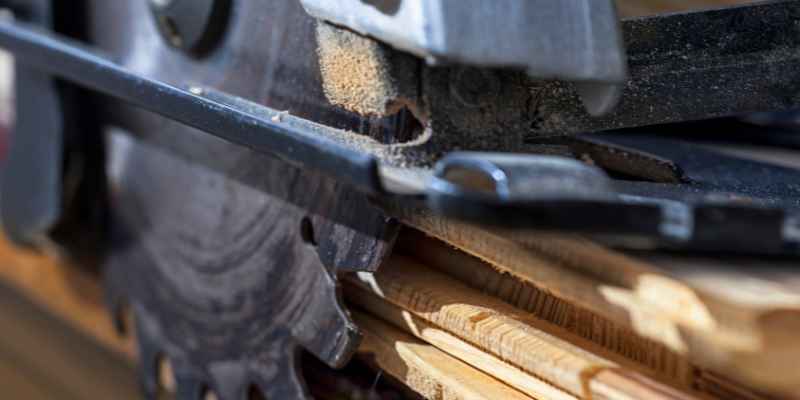Dado with a circular saw is a technique used to create wide, rectangular grooves or slots in wood. It involves making multiple passes over the same area to achieve the desired width.
This method is commonly used in woodworking projects such as joinery, cabinetry, and shelving. By carefully adjusting the saw’s depth and guide, you can create clean and precise dado cuts. This guide will provide you with step-by-step instructions on how to dado with a circular saw, ensuring successful results in your woodworking endeavors.
Importance Of Dado Cuts
Dado cuts are crucial for creating strong joints and shelves in woodworking projects. Using a circular saw for dado cuts allows for precise and efficient cuts, making the process easier and more accurate. This technique is essential for achieving tight-fitting and stable joints in various woodworking applications.
Benefits Of Dado Cuts
Dado cuts play a crucial role in woodworking projects, offering several benefits and advantages to craftsmen. Whether you’re a beginner or an experienced woodworker, understanding the importance of dado cuts can greatly enhance your woodworking skills. By employing the technique of dado cuts, you can achieve cleaner, more precise joints, strengthen connections between pieces of wood, and create visually appealing designs. Let’s delve into the various benefits of dado cuts that make them an essential technique in the world of woodworking.
Common Uses Of Dado Cuts
Dado cuts find widespread application in a multitude of woodworking projects, allowing craftsmen to create sturdy and visually appealing structures. The versatility of dado cuts makes them suitable for various applications, such as shelving, cabinetry, bookcases, and more. Here are some common uses of dado cuts in woodworking:
- Shelving and Bookcases: Dado cuts are frequently utilized in constructing shelves and bookcases due to their ability to provide strong and secure joints. By incorporating dado joints, you can ensure that your shelves can withstand the weight of books and other items without sagging or collapsing.
- Cabinetry: Dado cuts are commonly employed in assembling cabinet boxes and drawers. These joints create a seamless and stable connection between the different components of cabinets, ensuring durability and longevity.
- Decorative Panels: Dado cuts can be used to create intricate patterns and designs on decorative panels. By carefully cutting dado grooves, you can insert decorative trim or inlay materials, adding a unique touch to your woodworking projects.
- Joinery and Framing: Dado cuts are essential for joinery and framing applications, enabling the secure attachment of various parts. This technique is particularly useful when constructing frames for doors, windows, and other structural elements.
In conclusion, dado cuts offer numerous benefits and are commonly used in woodworking for their precision, strength, and versatility. By understanding the importance of dado cuts and their various applications, you can elevate the quality of your woodworking projects to new heights. Mastering this technique will enable you to create stunning and structurally sound pieces that stand the test of time.

Essential Tools For Dado Cuts
When it comes to creating precise and clean dado cuts with a circular saw, having the essential tools at your disposal is crucial. Whether you are a woodworking enthusiast or a professional carpenter, understanding the equipment needed for this task is vital for achieving accurate and professional results. In this section, we will explore the important tools required for making dado cuts with a circular saw.
Circular Saw Overview
A circular saw is a versatile and powerful tool that is commonly used for various woodworking projects. Equipped with a round flat blade, it is capable of making straight and precise cuts in different types of materials, including wood, plywood, and laminate. Circular saws are available in corded and cordless models, offering flexibility and mobility for different cutting applications.
Dado Blade Features
Dado blades are specialized attachments designed for creating dado cuts with a circular saw. These blades consist of multiple stacked cutters that enable the saw to make wide and smooth grooves in the workpiece, ideal for inserting shelves, panels, and other joinery components. Most dado blades are adjustable, allowing users to achieve various groove widths by adding or removing the included chippers. Additionally, some dado blades feature anti-kickback designs and vibration-reducing technology to ensure safety and accuracy during operation.
Preparing For Dado Cuts
Learn the essential steps for preparing dado cuts using a circular saw. This guide provides easy-to-follow instructions for achieving precise and clean results.
Setting Up The Circular Saw
Before making dado cuts with a circular saw, ensure the saw is properly set up for accuracy.
- Secure the workpiece firmly to prevent movement.
- Adjust the saw blade depth to match the desired dado width.
- Use a guide or fence to maintain straight cuts.
Choosing The Right Dado Blade Size
Choosing the correct dado blade size is crucial for achieving the desired outcome.
- Select a dado blade that matches the width of your intended dado cut.
- Consider the thickness of the workpiece when selecting the blade size.
- Ensure the arbor of the saw can accommodate the dado blade size.
Mastering Dado Techniques
Adjusting Cutting Depth
Ensure correct blade depth to create precise dado widths.
Maintaining Control And Accuracy
Keep a steady hand and focus on the guide while cutting.
Hope you find the above information useful! Let me know if you need further assistance.
Safety Measures To Consider
When working with a dado blade and a circular saw, safety should always be your top priority. Follow these essential safety measures to protect yourself and ensure a successful woodworking experience.
Wearing Proper Safety Gear
Before you begin using a dado blade with a circular saw, it is crucial to wear the right safety gear. This will help safeguard you from any potential injuries. Ensure that you have the following safety gear:
- Safety glasses or goggles: Protect your eyes from flying wood particles or debris.
- Ear protection: Reduce the risk of hearing damage from the loud noise produced by the circular saw.
- Dust mask or respirator: Prevent inhalation of sawdust and other harmful particles.
- Gloves: Protect your hands from cuts or splinters.
- Appropriate footwear: Wear closed-toe shoes or boots to protect your feet from potential falling objects.
Having the right safety gear ensures that you are well-protected and minimizes the risks of accidents or injuries while working with a dado blade.
Securing Workpiece
Securing your workpiece is crucial when using a dado blade with a circular saw. Keeping your workpiece stable throughout the cutting process helps prevent kickback and enhances accuracy. Here are some important tips to consider:
- Use clamps: Secure the workpiece firmly using clamps to keep it from shifting while cutting.
- Support the workpiece: If the workpiece is large or heavy, use auxiliary supports or a sawhorse to provide additional stability.
- Mark cutting lines: Clearly mark the cutting lines on the workpiece to ensure accurate and precise cuts.
- Consider an anti-kickback device: Install an anti-kickback device on your circular saw to prevent the workpiece from being thrown back towards you.
By following these steps and taking the necessary precautions, you can secure your workpiece effectively and reduce the chances of accidents or errors while using a dado blade with a circular saw.
Troubleshooting Dado Cut Issues
When it comes to making dado cuts with a circular saw, it’s not uncommon to encounter a few issues along the way. However, with some troubleshooting techniques, you can overcome these problems and achieve clean and precise dado cuts. In this section, we will discuss two common issues and their solutions: preventing tearout and dealing with blade deflection.
Preventing Tearout
Tearout is a common issue that occurs when the circular saw blade cuts through the wood, leaving unsightly splinters or rough edges. However, there are a few measures you can take to prevent tearout and achieve clean dado cuts:
- Use a sharp blade: Make sure to use a sharp blade specifically designed for dado cuts. A dull blade can cause tearout, so it’s crucial to keep your blade sharp or replace it when necessary.
- Adjust the cutting depth: Setting the depth of the circular saw blade is crucial in preventing tearout. Adjust the depth so that the blade only cuts through the wood, without going too deep or too shallow.
- Score the cutline: Create a shallow scoring line along the cutline using a utility knife or a scoring tool. This will help guide the circular saw and minimize tearout.
- Use a sacrificial board: Placing a sacrificial board underneath the workpiece can help reduce tearout. The sacrificial board acts as a support, preventing the wood fibers from splintering as the blade exits the workpiece.
Dealing With Blade Deflection
Blade deflection is another issue that can adversely affect the quality of dado cuts. Blade deflection occurs when the blade bends or flexes during the cutting process, resulting in uneven and inaccurate cuts. Here are a few methods to combat blade deflection:
- Use a quality blade: It’s important to invest in a high-quality circular saw blade that is specifically designed for dado cuts. A sturdy and rigid blade will minimize deflection and ensure a smooth cutting experience.
- Reduce the feed rate: Pushing the workpiece too quickly through the blade can increase the chances of blade deflection. As you make the cutting motion, maintain a steady and controlled feed rate to avoid any bending of the blade.
- Use a straight edge or guide: Using a straight edge or a guide can help keep the circular saw aligned during the cut, reducing the chances of blade deflection. Make sure the guide is firmly secured to the workpiece to ensure accuracy.
- Check for a loose blade: Before making dado cuts, always double-check to make sure the blade is tightly secured in the circular saw. A loose blade can result in deflection and compromise the quality of your cuts.
By following these troubleshooting techniques and taking the necessary precautions, you can overcome tearout and blade deflection issues when making dado cuts with a circular saw. With practice and attention to detail, you’ll be able to achieve clean and precise dado cuts for all your woodworking projects.
Advanced Dado Cutting Tips
Are you ready to take your woodworking skills to the next level? If you’ve mastered the basics of using a circular saw to create dado joints, it’s time to explore some more advanced dado cutting tips. These tips will help you achieve precision and efficiency in your woodworking projects while using a dado with a circular saw. Read on to discover the secrets of creating flawless dado joints and using dado stacks effectively.
Creating Dado Joints
When creating dado joints with a circular saw, precision is key. Start by marking the exact placement of the dado on your workpiece. Use a straight edge or square to ensure the lines are perfectly parallel to the edge of the board. Next, set the depth of your saw blade to match the thickness of the material you’re using, and make a series of parallel cuts within the marked area. Once the cuts are made, use a chisel or router to clean up the bottom of the dado and ensure a precise, flat surface for a perfect fit.
Using Dado Stacks
When it comes to using dado stacks, it’s important to choose the right combination of blades and shims to achieve the desired width for your dado joint. Start by arranging the desired combination of blades and shims on your saw’s arbor, ensuring they are stacked in the correct order. Securely tighten the arbor nut to hold the stack in place and make a test cut on a scrap piece of material to verify the width of the dado. Make adjustments as needed until you achieve the perfect fit for your project.

Final Thoughts And Practice
Now that you have gained a solid understanding of using dado with a circular saw, it’s time to put that knowledge into practice. By incorporating dado cuts into your projects, you can elevate the craftsmanship and precision of your woodworking creations. It’s also essential to engage in practice exercises to enhance your skills and ensure accuracy in your dado cuts.
Practice Exercises For Precision
Practice is key to honing your dado cutting skills. Set up scrap wood pieces and practice making dado cuts using different blade depths and angles. This will help you gain a better feel for the saw and improve your precision when creating dado joints in actual projects.
Incorporating Dado Cuts In Projects
Utilizing dado cuts in your woodworking projects adds both functionality and aesthetic appeal. Whether you are constructing shelves, cabinets, or drawers, integrating dado joints can enhance the structural integrity of your pieces while providing a clean and seamless finish.
Frequently Asked Questions Of Dado With A Circular Saw
How Do You Choose The Right Dado Blade For A Circular Saw?
To choose the right dado blade for a circular saw, consider the blade size, arbor size, and the material you plan to cut. Ensure the dado blade is compatible with your saw and follow the manufacturer’s recommendations for safety and performance.
What Safety Precautions Should I Take When Using A Dado With A Circular Saw?
When using a dado blade with a circular saw, always wear eye and ear protection. Ensure the saw is turned off and unplugged when changing the blade. Use a push stick to keep your hands and fingers away from the blade, and follow all safety guidelines provided by the tool manufacturer.
Can I Use A Dado Blade With Any Circular Saw?
Not all circular saws are designed to accommodate dado blades. It’s essential to check the saw’s specifications and the manufacturer’s guidelines to ensure compatibility. Using a dado blade with an incompatible saw can result in safety hazards and damage to the equipment.
Conclusion
Using a circular saw to create dado cuts can be a practical and efficient method for woodworking projects. With the proper techniques and safety precautions, this versatile tool allows for accurate and precise cuts. Incorporating dado joints in your projects can enhance the overall strength and stability of your furniture or cabinetry.
So, give it a try and explore the possibilities that dado cuts can bring to your woodworking projects.


